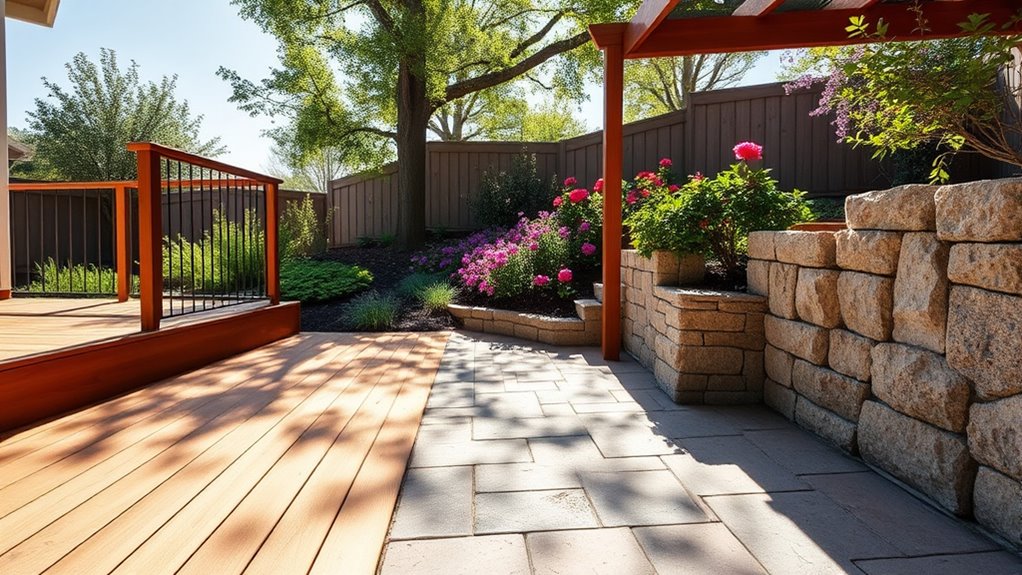If you’re choosing quickly between a deck and a patio, consider your budget, maintenance, and style. Decks often cost more initially but are great for lively gatherings and customization, while patios cost less upfront and need less upkeep. Think about durability—materials like composite or natural stone last longer. Also, match your outdoor space to your home’s style and purpose. Want to master these choices for a perfect fit? Keep exploring for more insights.
Key Takeaways
- Assess your budget: decks generally cost more upfront but may save on long-term maintenance, while patios are typically cheaper initially.
- Consider your intended use: decks are ideal for social gatherings and outdoor dining; patios suit relaxation and quiet retreats.
- Evaluate material durability: choose weather-resistant options like composite or natural stone for longevity and reduced upkeep.
- Match your outdoor space with your home style: rustic, modern, or traditional designs should complement your home’s architecture.
- Prioritize site preparation: ensure proper drainage and soil stability to prevent future issues and improve project longevity.
Understanding the Basic Differences

While decks and patios both provide outdoor living spaces, they have distinct differences you should consider. A deck is usually made of wood or composite materials, offering a raised platform that requires regular deck maintenance, like sealing and inspecting for rot or damage. In contrast, a patio is often built from concrete, stone, or pavers and sits directly on the ground, making patio cleaning simpler and less frequent. Decks tend to be more aesthetic but need ongoing upkeep to stay in top shape. Patios are generally low-maintenance but may need occasional power washing to remove dirt and stains. Understanding these fundamental differences helps you decide which option fits your lifestyle, maintenance capacity, and outdoor design goals. Additionally, considering trustworthiness of the brand can ensure you select quality materials that last longer and require less frequent repairs.
Budget Considerations and Cost Factors
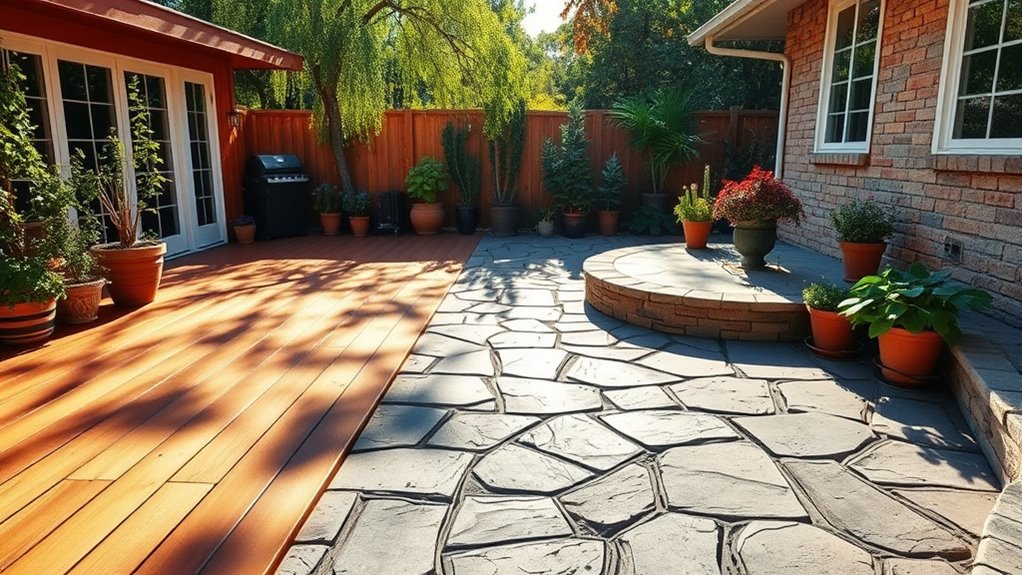
Budget considerations play a crucial role in choosing between a deck and a patio, as they can vary considerably in initial costs and long-term expenses. Material costs are a key factor; decks often require wood, composite, or vinyl, which can affect overall expenses. Patios typically involve concrete, pavers, or stone, which may have different price points. Installation expenses also differ: decks usually need framing, permits, and more labor, increasing costs, while patios might be simpler to install but require proper base preparation. Your choice depends on your budget and how much you’re willing to invest upfront versus over time. Remember, a higher initial cost can sometimes mean lower maintenance costs later, so consider both material costs and installation expenses carefully before making your decision. Additionally, understanding water usage and efficiency can influence your long-term savings, especially when selecting materials and designs.
Material Choices and Durability
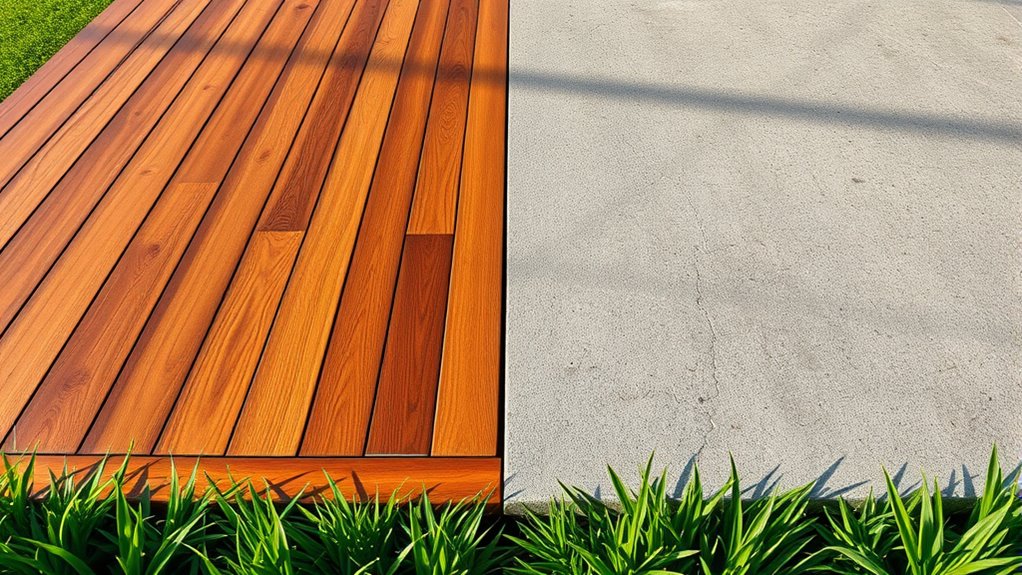
Choosing the right materials directly impacts the longevity and performance of your outdoor space. When selecting between a deck and patio, focus on material durability and weather resistance. Consider these three options:
- Composite decking – Known for its exceptional weather resistance and low maintenance, it resists fading, cracking, and warping.
- Natural stone – Offers unmatched durability, withstanding harsh weather while adding timeless elegance.
- Concrete – Versatile and resilient, it handles temperature fluctuations and moisture without issues. Incorporating proper sealing techniques can further enhance its lifespan and appearance.
Your choice affects how well your space endures seasonal changes and daily wear. Durable materials give you peace of mind, ensuring your outdoor area stays beautiful and functional for years to come. Prioritize weather resistance to avoid costly repairs and replacements down the line.
Maintenance and Upkeep Requirements
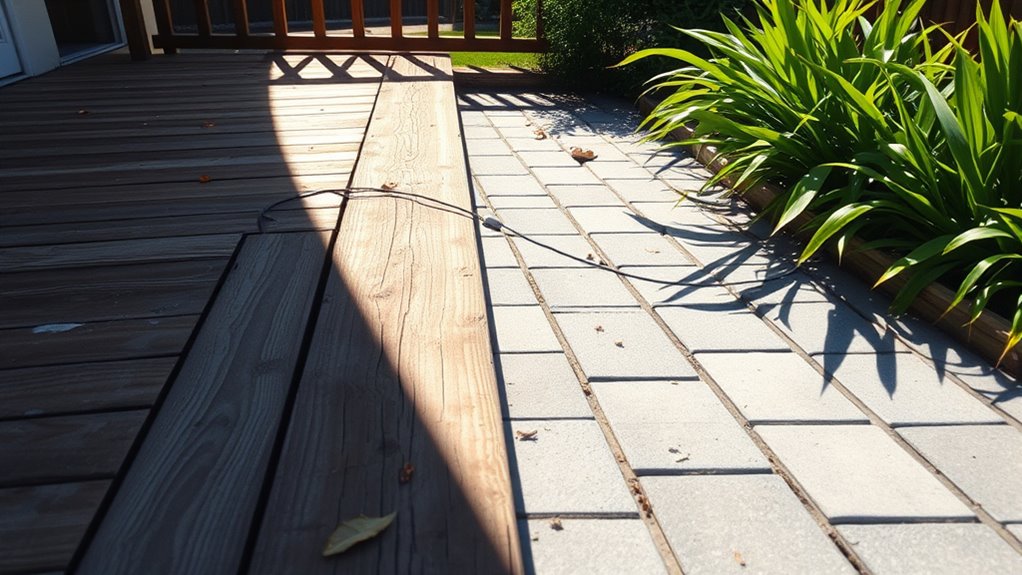
Maintaining a deck or patio requires regular attention to keep it looking its best and functioning properly. Your upkeep routines should include routine maintenance tasks like cleaning, sealing, and inspecting for damage. For decks, you’ll need to sweep away debris frequently and power wash annually to prevent mold and rot. Applying sealant protects the wood from moisture and UV damage, extending its lifespan. Patios, especially concrete or stone, benefit from sweeping and occasional washing to remove dirt and stains. Check for cracks or loose pavers regularly and repair them promptly. Both options demand consistent upkeep to prevent deterioration. Staying on top of these maintenance tasks ensures your outdoor space remains safe, attractive, and durable over time, saving you money and effort in the long run. Additionally, incorporating sound healing techniques or natural elements like plants can enhance the ambiance and overall enjoyment of your outdoor area.
Aesthetic Appeal and Design Flexibility
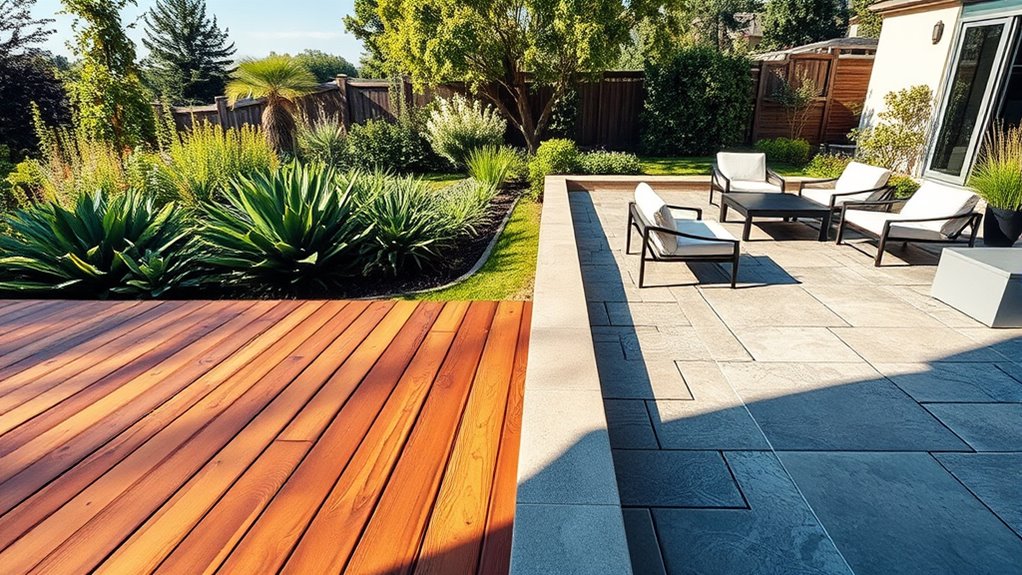
When it comes to enhancing your outdoor space’s visual appeal, both decks and patios offer distinctive design possibilities, but a deck often provides more flexibility for customization. With a deck, you can choose from various color schemes to match your style and incorporate decorative elements like built-in lighting or artistic railings that reflect your personality. Imagine:
- Creating a vibrant, lively atmosphere with bold colors and eye-catching accessories.
- Designing a cozy retreat with subtle tones and elegant decorative features.
- Customizing with personalized touches, such as engraved plaques or stylish planters.
These options allow you to craft an inviting space that resonates with your aesthetic. Decks give you the creative freedom to blend form and function seamlessly, making your outdoor area uniquely yours.
Installing and Construction Timeframes
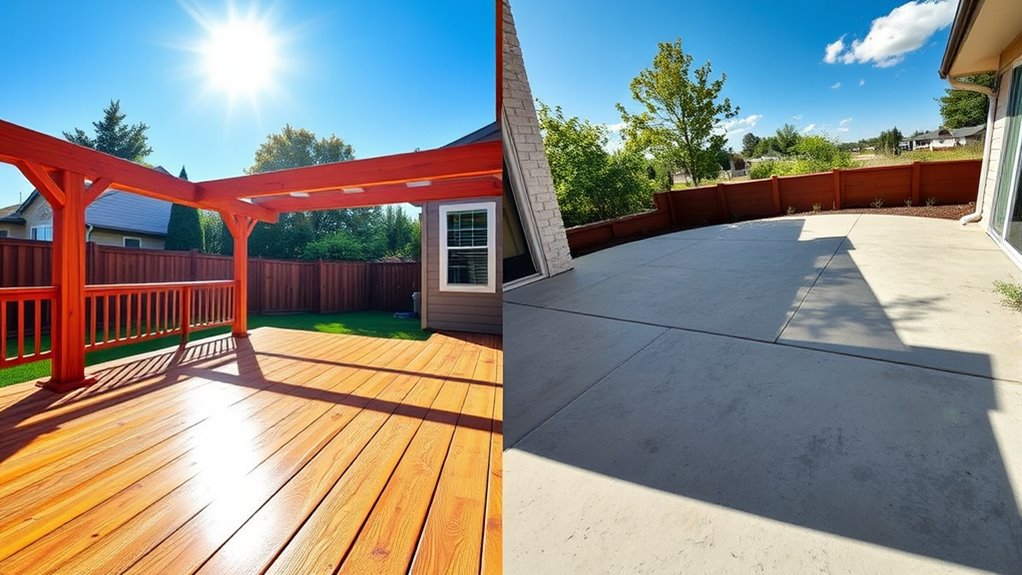
When comparing installation times, material selection speed plays a big role, with some options coming together faster than others. Permits and approvals can add unexpected delays, so understanding local requirements is essential. Additionally, site preparation duration varies depending on your space’s condition and the project’s complexity. Being aware of cookie consent and privacy considerations can also influence planning and scheduling to ensure compliance and smooth progress.
Material Selection Speed
Choosing between a deck and a patio often hinges on how quickly you want the project completed. Your material selection speed can markedly impact your timeline, especially with options that vary in style and color choices. Consider these factors: 1. Pre-made materials—like composite decking—are quick to install, saving you days. 2. Material style options, such as stamped concrete or natural stone, influence the complexity and timeframe of installation. 3. Color options can add aesthetic appeal fast, especially with ready-made products that come in multiple hues. If you prefer a swift setup, go for materials with fewer customization needs. Your choice directly affects how quickly your outdoor space transforms from plan to reality. Additionally, opting for versatile and adaptable materials can further streamline the process, making your project even more efficient.
Permits and Approvals
Permits and approvals can considerably impact your project’s timeline, as they often require time for processing and review. Before starting your deck or patio, you’ll need to check permit requirements specific to your location, which may include building permits or zoning approvals. The approval processes vary by municipality but generally involve submitting plans, paying fees, and waiting for official authorization. Delays can occur if your plans don’t meet local codes or if additional documentation is needed. It’s essential to factor in these steps early, so your project doesn’t face unexpected hold-ups. Securing permits typically takes anywhere from a few days to several weeks, depending on complexity and workload. Being proactive with permit requirements helps ensure a smoother, faster installation process. Additionally, understanding regulatory compliance can help prevent future legal issues and ensure your project adheres to all relevant laws.
Site Preparation Duration
Site preparation duration directly affects your project timeline, as it involves clearing, leveling, and building the foundation for your deck or patio. If the soil isn’t stable or drainage requirements aren’t met, delays can occur. Addressing these issues early is vital. Proper drainage setup helps prevent water damage and adds to initial prep. Consider these points: 1. Achieving soil stability can take time if the ground is loose or uneven. 2. Proper drainage setup prevents future water damage, adding to initial prep. 3. Rushing site prep risks structural problems and costly repairs later. A well-prepared site ensures your project stays on schedule and lasts longer. Ignoring soil stability or drainage needs might save time upfront but leads to delays and frustrations down the line. Efficient site prep keeps your project moving smoothly.
Compatibility With Your Home’s Style
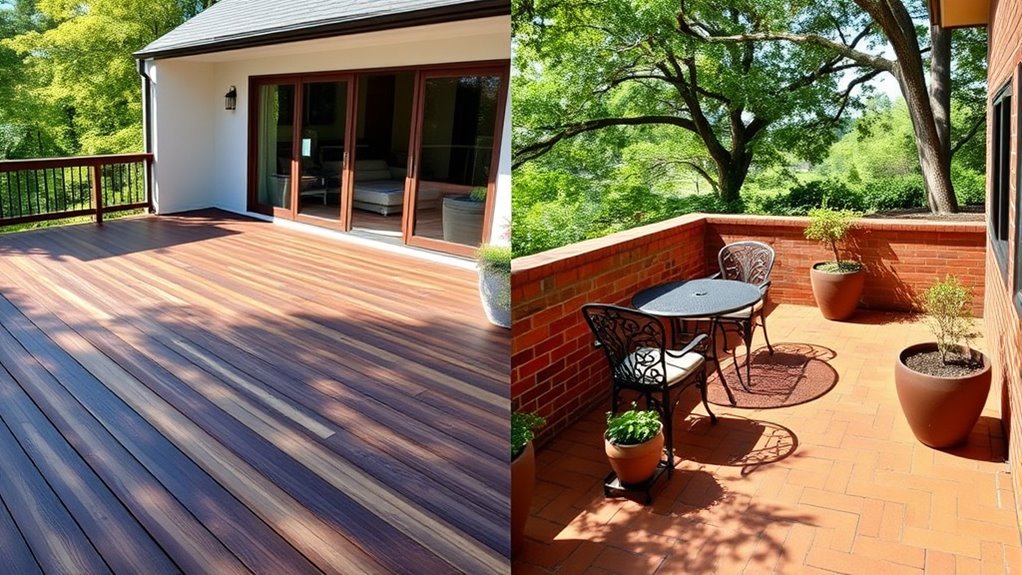
Your outdoor space should complement your home’s architecture and overall style. Consider how a deck or patio will blend with your existing design, creating visual harmony. The right choice enhances your home’s aesthetics and makes your backyard feel more inviting. Incorporating elements like rustic lighting or vintage decor can further unify your outdoor and indoor themes for a cohesive look.
Design Harmony With Architecture
Choosing a deck or patio that complements your home’s style creates a seamless look and enhances curb appeal. To achieve this, focus on design harmony with your architecture. First, consider landscaping integration—use plantings and materials that match your home’s exterior to create a unified feel. Second, select lighting options that highlight architectural features, adding warmth and character during evening gatherings. Third, pay attention to proportions and materials, ensuring your outdoor space aligns with your home’s style—whether it’s sleek modern or charming rustic. By thoughtfully blending these elements, your outdoor area feels like a natural extension of your home. This harmony not only elevates aesthetics but also boosts your overall enjoyment and property value.
Visual Impact and Aesthetics
To create a cohesive outdoor space, ensuring your deck or patio complements your home’s style is essential. Your choice influences overall visual impact and aesthetics, making your area inviting and harmonious. Consider color options that match or contrast your exterior palette—light hues can brighten, while darker tones add sophistication. Pattern variety also plays a key role, from sleek planks to intricate tiles, creating visual interest. Here’s a quick comparison:
| Aspect | Deck | Patio |
|---|---|---|
| Color options | Natural wood tones, painted | Concrete stains, tiles |
| Pattern variety | Plank layouts, borders | Tile designs, pavers |
| Style compatibility | Rustic, modern, traditional | Mediterranean, contemporary |
| Visual impact | Warm, inviting, textured | Elegant, sleek, durable |
Matching these elements with your home’s style boosts curb appeal and personal satisfaction.
Usage Purposes and Functionality
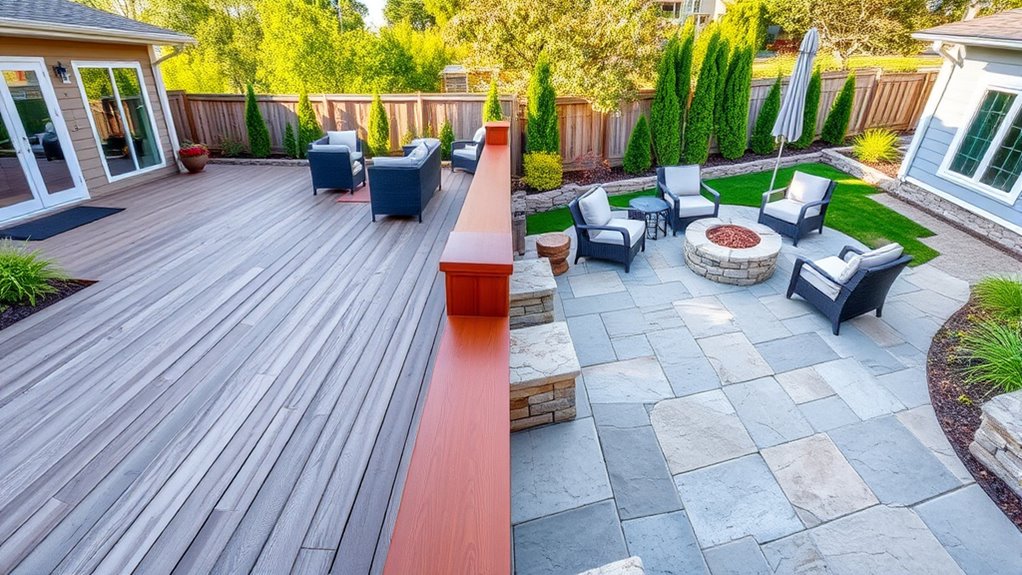
Understanding the primary uses of your outdoor space helps determine whether a deck or patio best suits your needs. If you’re hosting lively gatherings, a spacious deck offers ample room for seating and entertainment. For quiet relaxation, a cozy patio creates a perfect retreat. Consider these key purposes:
- Entertaining guests – A deck provides an open area for socializing and outdoor dining.
- Creating privacy – Both options can incorporate landscape features or privacy screens to enhance seclusion.
- Enhancing landscape integration – Tailoring your choice to blend seamlessly with your yard boosts overall appeal and functionality.
Environmental Impact and Sustainability
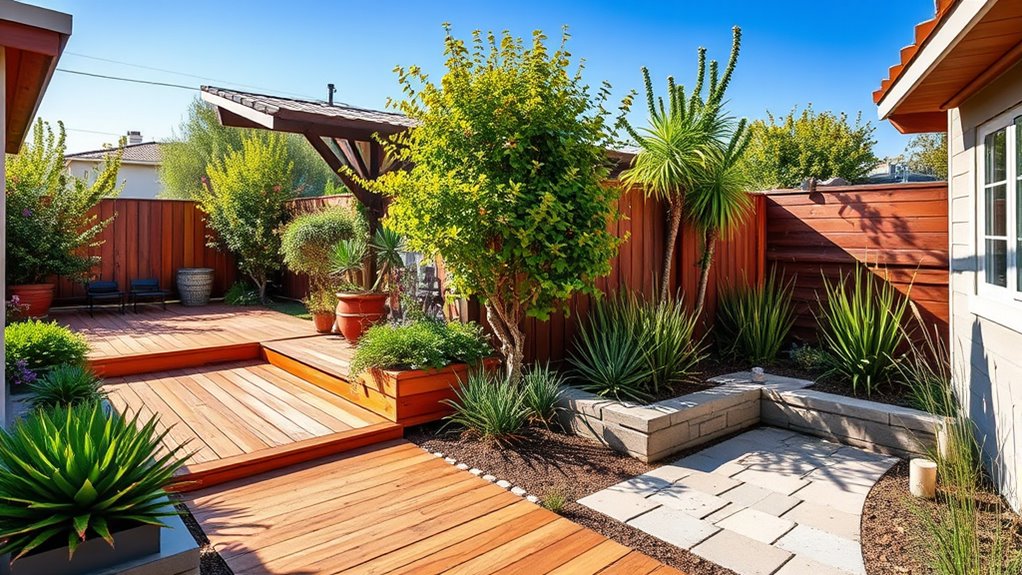
Both decks and patios can be designed with eco-friendly materials that minimize environmental impact, making sustainability a key factor in your decision. Using sustainable materials like reclaimed wood, composite decking, or permeable pavers helps reduce resource depletion and waste. Eco-friendly construction techniques also lower carbon emissions and lessen the burden on local ecosystems. When choosing materials, consider options that are durable and locally sourced to further enhance environmental benefits. By prioritizing eco-conscious choices, you contribute to a healthier planet while creating a stylish outdoor space. Whether you opt for a deck or patio, integrating sustainable materials ensures your project aligns with environmentally responsible practices and reduces long-term ecological footprints.
Long-Term Value and Resale Potential
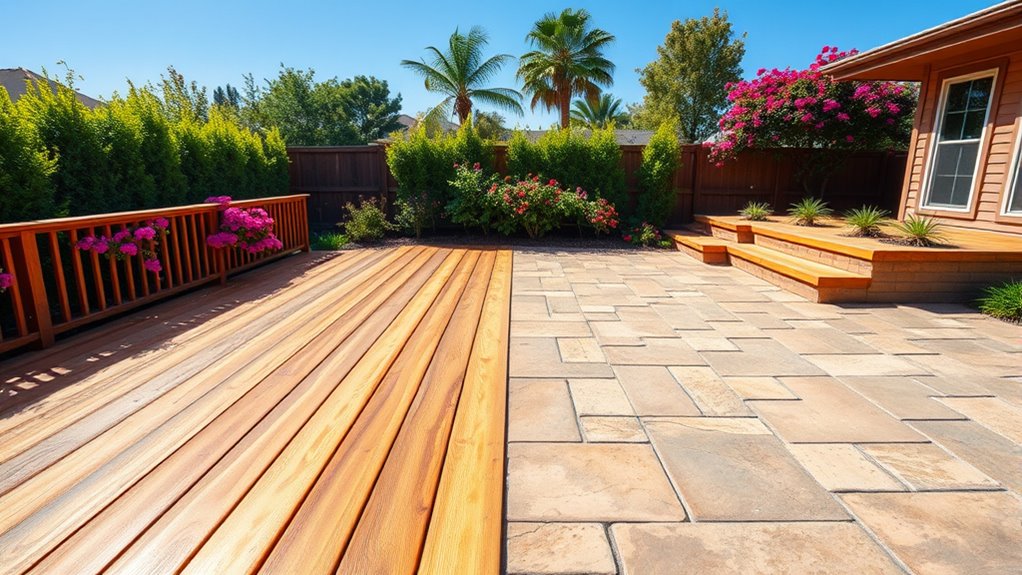
When considering long-term value and resale potential, your choice between a deck and a patio can markedly impact your home’s appeal. A well-designed space with smart landscaping integration enhances curb appeal and attracts buyers. Think about:
- Visual harmony — a deck with integrated landscaping creates a seamless outdoor experience.
- Nighttime allure — outdoor lighting boosts safety and highlights your space’s charm.
- Versatility — decks often provide higher perceived value, especially if built with durable materials.
A deck’s elevated design offers a better view and a sense of luxury, increasing resale value. Meanwhile, patios appeal to buyers seeking low-maintenance outdoor living. Both options, when thoughtfully enhanced with landscaping and lighting, can markedly boost your home’s attractiveness and long-term worth.
Frequently Asked Questions
Which Option Offers Quicker Installation: Deck or Patio?
A patio typically offers quicker installation than a deck. You can lay a patio in a few days, especially with existing landscaping options, making it ideal if you want fast results. A deck requires more planning, permits, and construction time, which can take weeks. If you prioritize speed and want to enhance your fence privacy quickly, a patio is your best choice, providing instant outdoor space without lengthy build times.
How Do Climate Conditions Influence Material Choice?
Climate conditions totally dictate your material choice—who knew? If you’re in a snowy wonderland, opt for durable, weather-resistant materials like composite decking or natural stone that can handle climate adaptation. Hot, sunny climates demand materials that resist fading and cracking, like concrete or tiles. Ignoring this advice turns your beautiful outdoor space into a weather roulette, so pick wisely and let your materials do the heavy lifting!
Can Decks and Patios Be Combined for Added Functionality?
Yes, you can combine decks and patios for added functionality by creating a multi-level design that seamlessly links the two. This approach maximizes space and aesthetic appeal, allowing you to host different activities comfortably. Incorporate integrated lighting to enhance safety and ambiance. By blending these elements, you’ll enjoy a versatile outdoor area perfect for entertaining or relaxing, tailored to your lifestyle and space.
What Safety Considerations Are Essential During Installation?
You need to prioritize safety equipment, structural stability, and proper installation techniques. Wear helmets, gloves, and eye protection throughout the process. Confirm the deck or patio is structurally stable by checking foundation integrity and load capacity before starting. Avoid shortcuts, and follow local building codes to prevent accidents. Proper safety measures protect you from injuries and ensure your project is secure, durable, and safe for everyone to enjoy.
Are There Any Permits Required for Deck or Patio Construction?
You’ll need to check if permits are required for your deck or patio construction. Typically, zoning regulations and property setbacks influence permit requirements, ensuring your project complies with local rules. Before starting, visit your city or county building department’s website or contact them directly. They’ll tell you if you need permits, what paperwork to submit, and any restrictions related to zoning or setbacks, helping you avoid fines or project delays.
Conclusion
Choosing between a deck and a patio is like selecting the perfect canvas for your outdoor masterpiece. Consider your budget, style, and how you’ll use the space. Picture your backyard as a vibrant garden of options—each element adding color and character. By weighing these factors, you’ll craft an inviting oasis that reflects your personality and enhances your home’s charm. Ultimately, your decision shapes a space that’s not just built, but beautifully lived in.
